Civilizations, Religions and Economic Integration
Economic Religious Areas: Hindu, Sinic, Islamic, Western, African, Orthodox
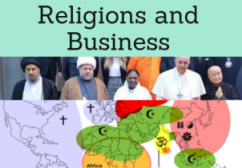
- Civilizations in a globalized world
- The eight major civilizations (economic and religious areas *) and the economic integration
- Economic Area of the African Civilization
- West African Economic Area
- Central African Economic Area
- Southern African Economic Area
- East African Economic Area
- Maghrebian Economic Area (Islamic Civilization)
- Interactions of the African Civilization
- Hindu Economic Area (India)
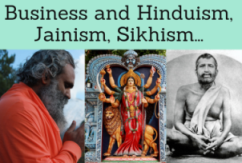
- Economic Area of the Sinic Civilization (China)
- Buddhist Economic Area
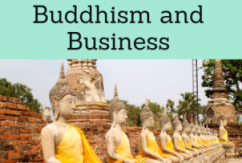
- Islamic Economic Area

- Arab Economic Area
- Central Eurasian Economic Area
- Malay Economic Area
- Maghrebian Economic Area
- African Economic Area (belonging to the African Civilization)
- Economic Integration of the Islamic Civilization
- Interactions of the Islamic Civilization
- Economic Area of the Western Civilization

- Economic Area of the Orthodox Civilization (Russia)

- Japanese Civilization
- Integration process between and within the civilizations
- Economic interrelations among the civilizations
(*) Central State (if exist).
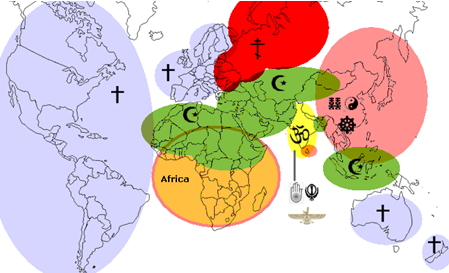

The module “Civilizations, Religions, and Regional Economic Integration” belongs to the following Online Programs taught by EENI Global Business School:
Masters: International Business, Religions & Business.
Doctorate: Ethics, Religions & Business, African Business, Islamic Business, World Trade.
Why study Religions and Business?.
Languages:  or
or  Civilizaciones e Integración
Civilizaciones e Integración  Civilizations et intégration
Civilizations et intégration  Civilizações e integração.
Civilizações e integração.

IMPORTANT NOTE:
This study is based on the analysis of the relationships between the current civilizations and the processes of economic integration, which, as can be observed, are closely related (regionalism).
According to the British historian Arnold Toynbee, the higher religions (such as Islam, Christianity, and Hinduism), through the Universal Church acted as “Chrysalis” favoring the evolution of the civilizations.
This new approach developed by EENI Global Business School based on the study of the economic relations between the civilizations will help the student to better understand the state of the World.
This does not mean that the analysis is based on a proselytizing vision of any religion, or considering one religion better than other. Nowadays it is clear, the relationship between the religions, the civilizations influenced by them and the current processes of intra- and inter-civilization economic integration.
The eight major economic - religious areas.
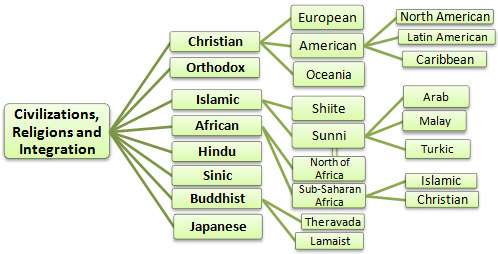
We are witnessing of the consolidation of a new world economic order; the regionalism may be displacing in some aspects to the Globalization. The “local and regional” component is every day more critical, especially in the sphere of business and culture.
If we look at the world we can identify eight major cultural - religious - economic areas, eight great civilizations usually led by a Central State and they have remained unchanged over the centuries.
The four religions with the largest number of followers (Christianity, Islam, Hinduism, and Buddhism) today represent 77% of humanity. It is estimated that:
- 32% of mankind, about 2,200 million people is Christian (being also the most globalized religion, average age of all the Christians: 30 years)
- 23% is Muslim (1,600 million, mainly in Asia and Africa. The average age: twenty-three years)
- 15% is Hindu (average age of twenty-six years) and
- 7% is Buddhist (average age of 34)
Taoism, Confucianism, Zoroastrianism, Jainism, or Sikhism could never become a Universal Church.
Based on the above we could hypothesize the following economic-religious areas:
Western Civilization.
From culture and economic integration; we can identify three distinct economic and cultural areas:
- European Economic Area
- American Economic Area
- North American Economic Area
- Latin American Economic Area
- Caribbean Economic Area
- Oceania Economic Area
Islamic Civilization.
1.57 billion people practices Islam (23% of the world's population). Only 15% of Muslims are Arab (Middle East). 62% of the World's Muslim population lives in Asia and 20% in the MENA region (the Middle East and North Africa). 300 million Muslims live in countries where Islam is not the majority religion.
Islamic economic areas:
- Arab Economic Area: Emirates, Bahrain, Saudi Arabia..
- Central Eurasian Economic Area: Iran, Pakistan, Turkey..
- Malay Economic Area: Brunei, Indonesia, and Malaysia
- Maghrebian Economic Area: Morocco, Algeria, Tunisia..
- African Economic Area, formed by the Muslim-majority African Countries (although it will encompass into the African Civilization)
We can consider two cultural distinct areas.
- Sunni. With Saudi Arabia as the central state. Within Sunni we can identify three sub-areas:
- Arab (Middle East)
- Malay (Southeast Asia)
- Turkic (Central Asia)
- African
- Shiite (Persian). Iran as the Central State
From a cultural point of view, North Africa, Egypt, Sudan, and Djibouti belongs to the Islamic Civilization (Sunni) and to the African Civilization. However, from the economic integration belongs mainly to the African Civilization.
Sinic Civilization.
The influence area of the Sinic Civilization covers China (Central State), Hong Kong, Japan, Vietnam, South Korea, and Singapore. China is also a BRICS Country.
In China, Taoism, Confucianism, and Buddhism are the main religions. However, surely, Confucianism is the religion that characterizes the Sinic Civilization.
Buddhist Civilization.
All the scholarships do not accept the existence of the Buddhist Civilization. Since our approach we will consider that there is a Buddhist Civilization (or emerging) and can be divided into three economic - cultural areas:
- Mahayana area
- Theravada area
- Lamaist area
Some of these countries can match with the influence area of the Sinic or the Hindu Civilization.
Hindu Civilization.
India is the Central State. India is also a BRICS country. The influence of the Hindu Civilization is notorious in Nepal, Mauritius, Bhutan, and East Africa.
Orthodox Civilization.
The Orthodox Civilization represents 35% of the European Christians (200 million). Russia (Central State) alone accounts for 19% of Christians in Europe and nearly 5% of the world's Christians.
The Orthodox Civilization consists of Belarus, Bulgaria, Cyprus, Georgia, Greece, Moldova, Montenegro, Macedonia, Russia, Romania, Serbia, and Ukraine.
African Civilization.
The vast majority of the Western historians, except Fernand Braudel, have not considered the existence of an African Civilization. However, its existence is evident, as demonstrated the great Senegalese historian Sheikh Anta Diop.
While Africa tends to the integration in a continental free-trade area; it is clear that there are five distinct areas:
- West African Economic Area
- Central African Economic Area
- Southern African Economic Area
- East African Economic Area
- Maghrebian Economic Area
Japanese Civilization.
Some scholars include the Japanese civilization within the Sinic Civilization. However, many scholars think that Japan itself is a civilization (a subsidiary of the Sinic Civilization). This civilization existed since the first century CE.
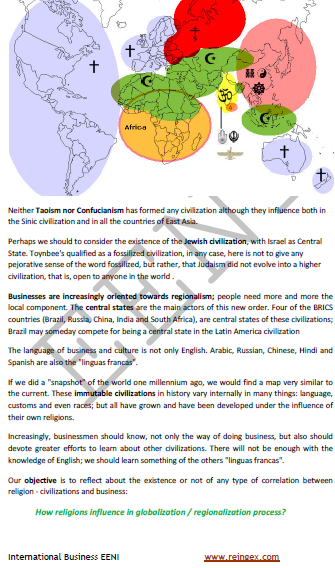
(c) EENI Global Business School (1995-2024)
We do not use cookies
Top of this page



